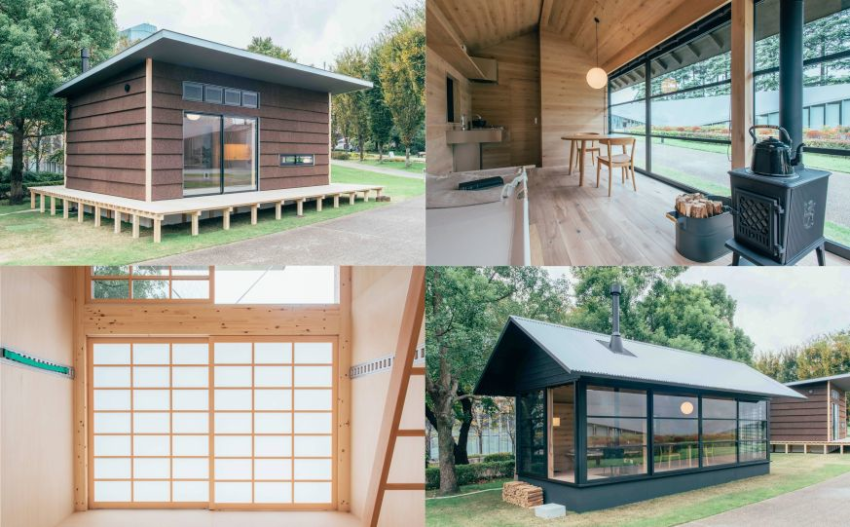Japan does small better than pretty much any other country in the world. From intricate origami to beautiful bonsai to sushi made with barely a dozen grains of rice, the Japanese people are known for their dexterity and attention to detail.
It should come as no surprise, then, to learn that Japanese retailer Muji is now getting into the tiny house movement and recently showcased its range of prefabricated ‘Muji Hut’ minimalist homes and hangouts.
As a keen follower of the tiny house movement, I’ve spent literally hundreds of hours poring over videos, plans and concepts of small, minimalist homes built either out of financial necessity or by those who wish to simplify their lives. These micro-home owners have an altogether different view of what a house should be, keeping their possessions to an absolute minimum (or creating clever storage solutions to keep them out of the way), designing their homes so that rooms function differently depending on the time of day, and embracing a lifestyle that favors the use of shared spaces. It’s not what you’ve got but how you use it, they maintain, and it’s hard to argue when you see how happy this approach to life makes them.
Although its name is more likely to conjure up images of beige rugs, plain lampshades and stationery than one of architecture and floor plans, Muji — known as Mujirushi Ryohin ("no-brand goods") in its homeland—has been building pre-fabricated homes for quite some time in Japan under the name of Muji House. These simple yet stylish homes are light, airy and functional, not to mention much more affordable than typical homes in Japan, and they seem to be growing in popularity every day.
And now, for those who want to downsize even further, the company has unveiled Muji Hut (photo above left) — a series of three prefabricated buildings of varying styles and dimensions suitable for either straight-up minimalist living or as weekend retreats or shelters.
First up is the ultra-small Arumi no Koya (“aluminium hut”) by industrial designer Konstantin Grcic. As its name suggests, the building is covered with in sheets of aluminium on all four sides, with a front that can be folded out to create additional shelter and a small deck, or closed for additional privacy and security.
The interior, while incredibly bare-bones, is surprisingly light and cosy thanks to the shoji paper doors on the front of the unit. The Arumi no Koya comes minus any kind of fittings besides a simple wooden ladder, but with its high ceiling and private loft space up above, this could easily be used as anything from a simple, single-person weekend dwelling to a artist’s studio or office space.
Next up is a design that fans of Japanese interiors will no doubt immediately fall in love with. The Koruku no Koya (“cork hut”) was designed by English product and furniture designer Jasper Morrison and features, as its name implies, cork cladding on its exterior as well as a narrow, distinctive Japanese-style deck which surrounds the building.
Morrison’s design features a simple kitchen area, dining space and spacious living/sleeping area fitted with soft tatami-mat flooring, perfect for lazing around on while the wood-burning fire in the corner gets the place nice and warm.
The third and final structure, Ki no Koya (“wooden hut”), was designed by Japan’s own Naoto Fukusawa and is perhaps the most livable of the three designs, even for those unfamiliar with the tiny house movement.
The interior features a kitchenette, bathtub, wood-burning stove and dining area. The entire front of the house, meanwhile, is covered in glass to allow for plenty of natural light to enter. It looks wonderfully snug and inviting and we desperately wish we lived here.
They may appear unfeasibly small to some of our readers in the west, but in actuality many of the “one-room” apartments let out in Japan’s urban hubs offer less floorspace than the Muji’s two larger weekend retreats here, so with some careful planning and cutting back on one’s worldly possessions living in one would be quite possible.
After all, as they always say about the things we own: “you can’t take it with you”…
Source: MUJI HUT
Read more stories from RocketNews24. -- Get the realistic Tumbler Batmobile you’ve always wanted… for your iPhone -- American man builds perfect, tiny Japanese house that could be yours for $70,000【Photos】 -- Famous websites like you’ve never seen them before… as fashionable dresses!
© Japan Today Take our user survey and make your voice heard.
Take our user survey and make your voice heard.















5 Comments
Login to comment
inkochi
Walking around my neighbourhood, and some of the houses were like these 'tiny' ones just with an extra storey.
Then in Kyoto, some of the newer replacements of older machiya look like these 'tiny' ones with two extra storeys.
Still, these beat those mono-oki metal/aluminium sheet things standing in a corner outside many home centers. Interesting!
JeffLee
Tempting for a Tokyoite to have something like that out in the Japanese countryside, where land is cheap. The problem is transport: you need a car, which are really expensive to maintain. And you need to travel at ungodly hours to deal with weekend congestion.
Moonraker
turbotsat
'No prices were available' said another article. 'For sale next year in Japan.'
Noble713
@JeffLee
??? Depends on what you drive, IME.....I've got a 280+hp rear-wheel drive Toyota sedan, and maintenance is the least of my worries: the ridiculous road tax schema and shaken are where all the money gets spent. The car itself doesn't need much more than regular oil changes (~$50), and then brake pads and tires every 1.5 years or so (maybe $1000 TOTAL, including labor).